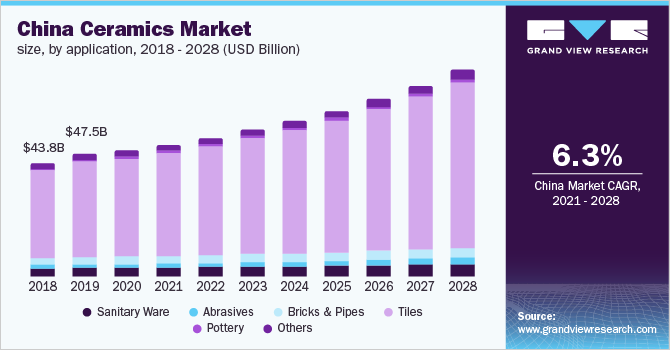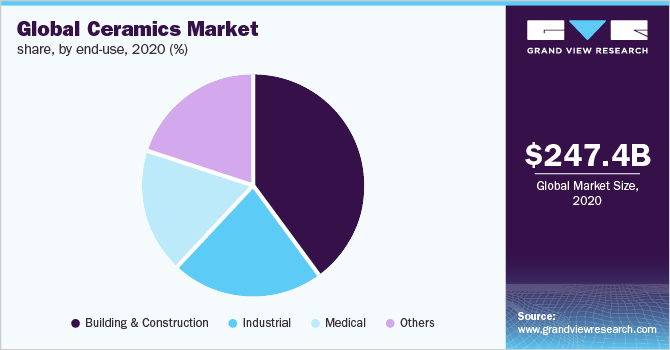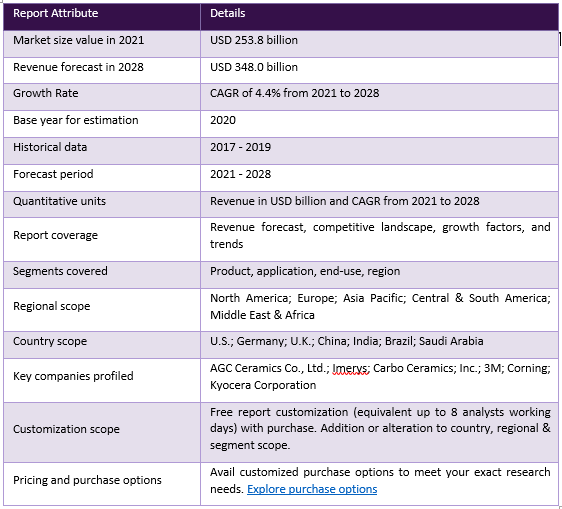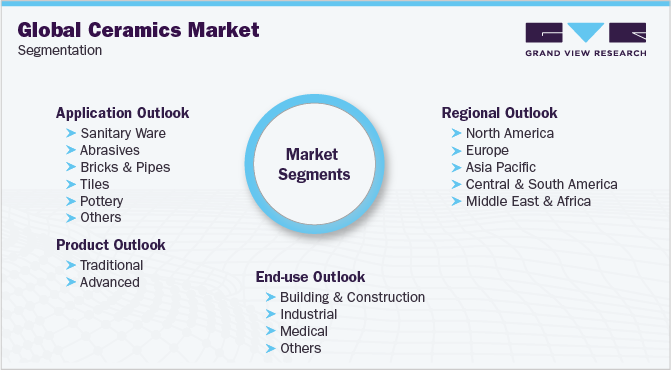Global Ceramic Tiles Market and Industry statistics
Table of Contents
Ceramics Market Size, Share & Trends Analysis Report By Product (Traditional, Advanced), By Application (Sanitary Ware, Abrasives, Tiles), By End-use (Building & Construction, Industrial), By Region, And Segment Forecasts, 2021 – 2028
Ceramic Tile Industry
The global ceramics market size was valued at USD 247.4 billion in 2020 and is expected to expand at a compound annual growth rate (CAGR) of 4.4% from 2021 to 2028. The usage of ceramics in manufacturing products such as tiles and sanitary ware is likely to flourish owing to steady growth in residential construction around the globe.

Furthermore, ceramics are expected to witness high penetration in the medical industry owing to their increasing utilization in manufacturing bioimplants. Growing investments in the medical industry on account of factors including coronavirus emergence and the rising elderly population is expected to augment market growth over the forecast period.
China is a key producer and consumer of ceramics, which are extensively used in tiles, sanitary ware, bricks, and abrasives. Furthermore, these are being preferred as raw materials in 3D printing as well. The growing adoption of 3D printed parts coupled with rising investments in this technology is anticipated to benefit product demand over the forecast period.
For instance, in November 2020, Syqe Medical employed XJet for producing high-precision, heat-resistant ceramic parts for the medical industry. Syqe Medical has XJet’s Carmel 1400 additive manufacturing system that helps in producing ceramic parts through inkjet printing using NPJ Technology.
———————————-
Read the article “the best ceramic tile importing countries“, for more information
———————————-
Furthermore, growth in the construction sector is another driving factor for the market. Ceramics are used in interiors in form of tiles, sanitary ware, and another décor. Shifting trend towards appealing interior along with rising investments in the residential and commercial construction to boost economic recovery in various countries is benefitting market growth.
The growth of the building & construction industry is another growth driver for the market. Various economies are witnessing positive growth and investments in the construction industry from 2020 to 2021. Ceramic products find application in interior and exterior tiles, sanitary ware, and in other complex structures such as chimney pipes, sewage, and bricks in the construction sector.
Click on link below to get more Information about the future of the global ceramic cermicworldweb.com
Global Ceramic Tiles Market Trends Report
The global ceramics market is mainly driven by the rising investments in the residential and commercial sectors, which is propelling the demand for ceramic-based products including sanitary ware and tiles. Moreover, the product is witnessing high penetration in the medical industry as well for making bioimplants. Growing advancements in medical technology and the rising number of orthopedic and dental patients are augmenting the need for ceramic implants worldwide.
Ceramic is defined as a non-metallic and inorganic material that hardens over a period of time when heated at a high temperature. Ceramics are made in various combinations of clay to produce the desired mold shape. Ceramics can be segmented into traditional and advanced. Traditional ceramics are produced using natural materials such as clay, quartz, or feldspar, while advanced ceramics make the use of synthetic powders of silicon carbide, aluminum oxide, and silicon nitride. The structure of traditional ceramics depends on the clay composition, while alterations can be made in the chemical compounds used for producing advanced ceramics.
The rising demand for high-quality and functional safety in medical devices has augmented the need for reliable materials such as ceramics. These are preferred in the medical industry owing to their flexible and customizable properties based on application requirements. Various applications of ceramics in the medical industry include acetabular cups & femoral heads for hip replacement, dental implants & restorations, bone fillers, and scaffolds for tissue engineering. Factors such as the toughness and strength of the product are projected to augment its demand over the forecast period.
—————————————
Read the article “best online market to buy tile“, for more information
—————————————
The demand for overall ceramics was obstructed in 2020 owing to the COVID-19 pandemic. The coronavirus spread affected the global supply chain, thereby impacting the production and the consumption of ceramics in numerous applications. Ceramic companies across the world also reported losses. For instance, RAK Ceramics reported a loss of DH 130 million (~USD 35.4 million) in 2020. The revenue of the company declined, and impairments also increased due to the COVID-19 pandemic-induced economic slowdown.
The market, however, picked up pace in 2021 and is expected to witness significant growth over the next eight years. A boost in defense spending by countries including the U.S. and China has benefitted the advanced ceramics market in the past few years, and this trend is anticipated to continue ahead as well. Alumina, silicon carbide, aluminum nitride, titania, and zirconia are some of the key ceramic materials used in various applications. They are used as ceramic coatings, monolithic ceramics, and ceramic matrix composites. Zirconia is mostly used for the production of protective coatings. It is also used for developing oxygen sensors in their stabilized form.
The ceramics market often faces raw material fluctuations. The cost of raw materials, such as alumina and zirconia, is high compared to alloys and metal counterparts. Therefore, the high cost restricts the use of alumina-based and zirconia-based ceramic membranes in commercial applications. However, alumina and zirconia are preferable in various applications owing to their properties such as refractoriness, stability, purity, and chemical inertia.
CP is the leading company in the field of supplying wholesale ceramic tiles. We serve a good number of buyers and suppliers around the world. Our company is structured to be one of the major companies supplying and exporting ceramic tiles in large quantities. We are committed to providing authentic, fast, and innovative services, in an effort to move up the business ladder successfully and more importantly, flourish in the field of supplying ceramic tiles. Last but not least, we are flexible on any terms you want, offering best-in-class ceramic tiles in any large amount according to your desire.
To get to know us more, click here.
To order registration or to buy tile from Iran, click here.
Ceramic Tiles Market Share, Analysis and Forecast
The traditional segment dominated the market for ceramics and held the largest revenue share of more than 58.0% in 2020. The segment witnessed tremendous growth over the past few years and is expected to dominate across the forecast period on account of the increasing application of traditional ceramics in the manufacturing of clay bricks, tableware, and porcelain tiles.
Traditional ceramics are primarily composed of silica (quartz), feldspar, and clay. These minerals in various combinations are used in the manufacturing of ceramic tiles and other ceramic-related finished products. Increasing demand for tiles and tableware are thus, projected to boost segment growth over the coming years.
Advanced ceramics is expected to witness substantial growth over the next eight years. These materials exhibit a very high degree of resistance towards wear and tear and at high temperatures. This has resulted in the rising demand for advanced ceramics from various industries including heavy machinery, automotive, energy, healthcare, cutting tools, and defense.
—————————————
Read the article “best ceramic tiles exporting countries“, for more information
—————————————
Application Insights
The sanitary ware segment dominated the market for ceramics and held the largest revenue share of more than 11.0% in 2020. Ceramics are used in producing various products under this segment such as shower plates, washbasins, bathtubs, and toilet bowls. In addition to being cost-efficient, ceramic-based products are easy to clean and maintain.
Furthermore, ceramic-based sanitary ware products are considered as suitable alternatives for steel and fiber sanitary ware owing to their superior characteristics such as abrasion resistance, corrosion resistance, glossy surface, and availability in various colors. Rising investments in luxury construction is expected to benefit product demand over the forecast period.
The abrasives segment is expected to progress at a CAGR of 3.9% in the market for ceramics over the forecast period. These are used in tools that are widely utilized in various operations such as grinding, cutting, dressing, polishing, sharpening, and dressing, particularly for metal, wood, glass, stone, and plastics. In addition, they are used to prepare surfaces for the application of paints or adhesives.
Ceramics are largely utilized in the making of products such as art ware, figurines, sculptures, earthenware, stoneware, porcelain, and bone china. Rising consumer interest toward interior decoration is likely to positively influence the demand for such products and thus, benefit product demand over the forecast period.
End-use Insights
The building and construction segment dominated the market for ceramics and held the largest revenue share of over 40.0% in 2020. Growth in residential and commercial construction along with public and other infrastructural works is stimulating the segment growth. Rising government focus on affordable housing in various regions is anticipated to augment segment growth over the coming years.

In industrial end-use, advanced ceramics are employed in various applications in aerospace, chemical, petrochemical, and coatings. In the aerospace sector, ceramics are used in the manufacturing of space shuttle tiles, wear components, combustor liners, and fire detection equipment among others. Thus, growth in the industrial sectors is expected to propel the product demand in the coming years.
Ceramic Tile Industry statistics
Asia Pacific dominated the market in past and this trend is anticipated to continue over the forecast period. The presence of growing economic powerhouses such as India, China, Thailand, and other South Asian countries is expected to drive the ceramics market in the region. Furthermore, the region is witnessing rapid growth and investments in the medical industry, which is further expected to promote market growth.
China is one of the fastest-growing healthcare markets in the world that is projected to grow at an annual CAGR of 13% over ten years. The country had the second-largest healthcare market in the world in 2019 with a total expenditure of up to USD 1.02 trillion. Thus, the healthcare industry of China is expected to offer potential growth opportunities to manufacturers of ceramics as they are used in medical components and equipment. This, in turn, is anticipated to drive the growth of the ceramic market in China from 2021 to 2028.
North America ceramics market is anticipated to observe steady growth over the forecast period. The demand for ceramic tiles in the region is expected to ascend significantly over the coming years on account of the increasing construction of residential and commercial buildings. Furthermore, the rising emphasis on the development of the domestic ceramic tiles industry, which is supported by the growing demand from walling and flooring applications is aiding the market growth. Several Italian companies are increasingly investing in the regional market owing to abundant raw material availability and a huge customer base.
Increasing investments in both single and multi-family housing projects along with growth in the renovation industry is propelling the demand for products such as sanitary ware and tiles. Moreover, the U.S. medical devices industry is highly recognized across the globe for innovative technologies and products. The medical devices market relies on several industries including telecommunications, microelectronics, biotechnology, instrumentation, and software development, wherein the country holds a competitive edge.
Key Companies & Market Share Insights
The global ceramics market is extremely competitive owing to the presence of numerous small and large players worldwide. Multiyear agreements, new product development, and capacity expansion are the key strategies adopted by the market players to strengthen their market positions.
Companies have been trying to innovate new processes to develop an efficient way to manufacture ceramic end-products at low cost and in industrial-scale quantities. Many manufacturers are focusing on regional expansion to capture wider target customers. Research initiatives and mergers & acquisitions by manufacturers are expected to augment the growth of the ceramics industry over the forecast period. Some of the prominent players in the global ceramics market include:
- AGC Ceramics Co., Ltd.
- Kajaria Ceramics Limited
- Kyocera Corporation
- Mohawk Industries, Inc.
- Momentive
- Morgan Advanced Materials
- RAK Ceramics
- Saint-Gobain
- Unifrax
Ceramics Market Report Scope

Global Ceramics Market Segmentation
This report forecasts revenue growth at the global, regional, and country levels and provides an analysis of the latest industry trends in each of the sub-segments from 2017 to 2028. For the purpose of this study, Grand View Research has segmented the global ceramics market report on the basis of product, application, end-use, and region:

To learn more about this report, request a free sample copy
- Product Outlook (Revenue, USD Billion, 2017 – 2028)
– Traditional
– Advanced
- Application Outlook (Revenue, USD Billion, 2017 – 2028)
– Sanitary Ware
– Abrasives
– Bricks & Pipes
– Tiles
– Pottery
– Others
- End-use Outlook (Revenue, USD Billion, 2017 – 2028)
– Building & Construction
– Industrial
– Medical
– Others
- Regional Outlook (Revenue, USD Billion, 2017 – 2028)
– North America
U.S.
– Europe
Germany
U.K.
– Asia Pacific
China
India
– Central & South America
Brazil
– Middle East & Africa
Saudi Arabia
Reference: https://www.grandviewresearch.com/industry-analysis/ceramics-market
FAQ,s
China/India/ Brazil/Vietnam/Spain/Italy/Iran
Italy/Turkey/Spain/Iran
US/Italy/Mexico/Turkey
قیمت های موجود در سایت تاریخ بروزرسانی آن ها ذکر شده و قیمت نهایی محصولات نمی باشند. لطفا جهت ثبت سفارش و استعلام قیمت بروز با کارشناسان ما در ارتباط باشید.
(035-3357)